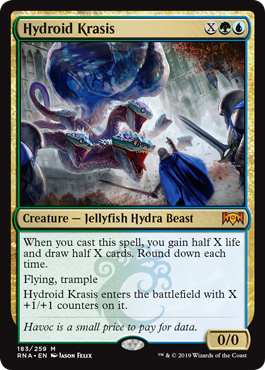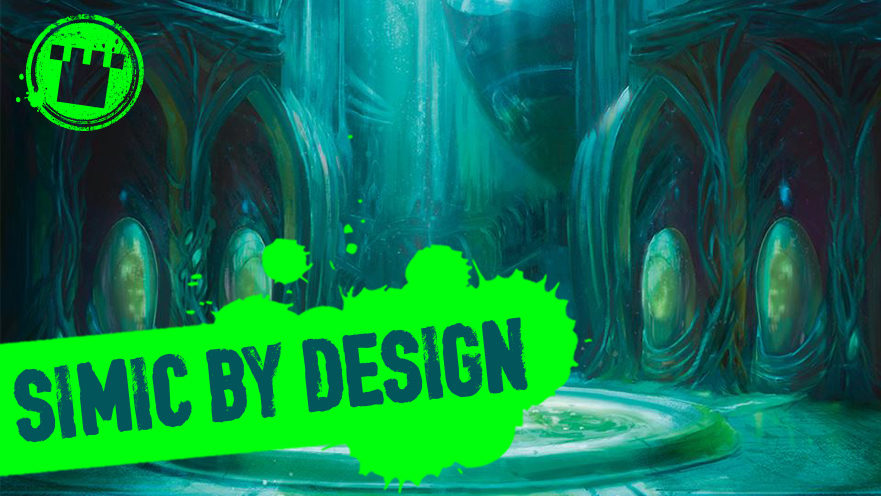Oh, hi! Are you the new test subject? …no? Shoot. Well, grab a seat, and let me tell you about my latest research – might as well pass the time until they arrive.
With Ravnica Allegiance, the Simic are resurfacing once again and with a new wardrobe (well, if getting extra crab arms or jelly legs can be classified as new outfits)! Last time we saw these biomancers, we were blessed with sharks that shamble; but, now, the Combine’s return begs the question: what Frankensteinian creation are we going to fall in love with next?
Ravnica Allegiance is the third set to feature the Simic and their creations. Because three makes a pattern, we can dissect what makes Simic creature cards tick. (Disclaimer: At the time of this writing, Ravnica Allegiance is only partially-previewed, so I may not be aware of some creature type combinations that are printed in this latest set.)
Let’s dive in. Or crawl in. Whatever your preferred method of travel is.
Creature Classifications
Not every Combine creature is a combined creature! In order to design Simic effectively, we must understand all the shapes and sizes they come in. Simic creatures can be categorized into one of the following: humanoids, hybrids, mutants, and oddballs.
Humanoids

Many of the Ravnican citizens within the Simic guild are humanoid. These folks may not have anything weird about them biologically, since they’re typically the ones performing the experiments.
These creature types are:
- Human
- Elf
- Merfolk
- Vedalken
Boring? Maybe, but you need scientists to do science! Besides, not everyone can become a Lizard Wizards.
Any grafting of additional race creature types with these ones fall under the next category…
Hybrids

Exciting possibilities! Hybrids happen when you take two different race creature types and squish ’em together! The Simic Combine tend not to repeat themselves when they create a hybrid creature…except, at least once, in Ravnica Allegiance: making other creatures into Frog Lizards! Classic move.
Hybrids usually have two creature types from two different non-humanoid races. They also splice non-humanoid traits onto humanoid creatures, especially recently with the Elf Crabs in their super-soldier project. The rarest hybrids have two different humanoid creature types – such as the Human Merfolk maze runner extraordinaire, Vorel of the Hull Clade!
Successful hybrid ventures before Ravnica Allegiance:
- Human Insect
- Human Merfolk
- Human Ooze
- Snake Elf
- Fish Crab
- Fish Beast
- Lizard Beast
- Lizard Drake
- Frog Beast
- Frog Lizard
- Crocodile Frog
New hybrids previewed with Ravnica Allegiance:
- Elf Crab
- Elf Lizard
- Elf Ooze
- Jellyfish Hydra Beast (Simic’s first “three-brid” creature!)
“But wait!” you interject. “What about Mutants?” What timing!
Mutants

Mutants are “Mutants” in addition to having one other creature type. This was a popular thing to do back in Momir Vig’s day, when globs of cytoplast (the squishy bubbles depicted in the card art) could be grafted onto anything.
In rare cases, the mutated creature’s second creature type may not even be discernable based on its appearance in card art.
Simic-mutated species thus far, before Ravnica Allegiance:
- (None) Mutant
- Human Mutant
- Vedalken Mutant
- Basilisk Mutant
- Beast Mutant
- Bird Mutant
- Elemental Mutant
- Fish Mutant
- Frog Mutant
- Ooze Mutant
- Plant Mutant
- Spider Mutant
- Troll Mutant
Ravnica Allegiance has this new Mutant species:

…And there might be more to come!
Now, I know what you’re thinking: not everything that isn’t humanoid in the Simic Combine is a hybrid or a mutant. Right you are. But there’s definitely something WEIRD about them.
Oddballs

An oddball in Simic has a very normal type line, such as “Creature – Snake,” but, something’s… different. Like a FLYING SNAKE! If a Simic creature card isn’t a humanoid, a hybrid, or a mutant, it has to have some ability that distinguishes it from other creatures of its type.
Simic’s tweaked creatures:
- Beast (they fly!)
- Drake (spawned from a land!)
- Elemental (transformed from a land!)
- Frog (it turns others into itself!)
- Homunculus (rootwalla ability!)
- Jellyfish (they’re stationary with defender, like some kind of plant!)
- Leviathan (they also fly!)
- Ooze (they can only exist when countering a spell!)
- Shapeshifter (it copies another then copies itself perpetually!)
- Snake (they fly, too!)
- Worm (that worm is almost Wurm-sized!)
Emergent Gameplay
With the four categories of Simic creatures defined, there still isn’t enough information to effectively create Simic critters. What are the correct ratios for each creature category? What creature types are acceptable? What must always be included and what are optional aspects of the guild to focus on? Let’s examine these in greater detail.
Creature Category Ratios

When Momir Vig espoused the virtues of cytoplasts, 50% of the creatures in Dissension were Mutants. There were virtually no hybrids, save for one card: Coiling Oracle. In Gatecrash, after the long-lost humanoid race Merfolk emerged, and after Momir Vig was out of the picture, we started seeing fewer Mutants and more hybrids and humanoids.
For Ravnica Allegiance, the Merfolk are here to stay, and there’s a rise in breeding the hybrid super-soldiers and sundry. Here’s a rough percentage estimation for each category of creature to follow:
20-25% Humanoids (without extra race types)
40-45% Hybrids (includes humanoids with extra race types)
10-15% Mutants
20-25% Oddballs
Acceptable Creature Types

Ready to mash up Ferrets and Trilobites? …oh, wait. This isn’t Unstable. No, there are METHODS to this madness.
In the current incarnation of the Simic, the kinds of creatures you can find that aren’t humanoids lean reptilian, amphibious, and semi-aquatic. There’s a sprinkling of strictly aquatic creatures, like Jellyfish; and we may even see an uptick in creature types like this nowadays, especially for the sake of fun mashups like Hydroid Krasis.
Additionally, specific non-humanoid creature types the Simic love include Frog, Lizard, Fish, Crab, Beast, and Ooze.
What to Include

Every set that Simic has appeared in has had the following, so think of them as essential components of the recipe that makes Simic:
- One or more Frogs
- At least one Mutant
- At least one Beast
- At least one Human
- An Ooze or counterspell depicting an Ooze
- A humanoid with an additional race creature type (this can be your Human, if desired)
- A single-typed oddball creature (this can be your counterspell Ooze, if desired)
- At least one creature type combination that has never been printed together on a card before
- Next, the following may or may not apply, based on two large sets (Dragon’s Maze being too small to fit these in) and/or latest paradigm:
- A flying multicolored Leviathan or Beast
- At least one Merfolk
- At least three Elves
Monster Mash

When designing the individual cards, how do you know what creature type combinations should mean in terms of power, toughness, and abilities? Here are some rough rules of thumb/claw/fin, based on existing creature type hybrids:
- Crabs have two power. (Weird, right?)
- Lizards have more power than toughness.
- If Beast is paired with exactly one other type, that other type is dominant. The Beast type is meant to augment or expand the capabilities of the other type. For example, Battering Krasis allows the hammerhead shark to be able to ram others on land rather than underwater.
- There’s always a three printed somewhere on the card if a Frog is involved.
- Mutants always mention the guild’s keyword, except for Experiment Kraj, who pretty much has a neat version of graft.
Next Generation

Some possible next steps the Simic can take as of today? Consider the following:
- A non-Insect, non-Ooze, non-Merfolk Human hybrid
- A Vedalken hybrid
- A Frog or Fish humanoid
- Mutant version of Elf, Merfolk, Lizard, Crab, or Snake
- Fish combined with Lizard or Frog
- Crocodile combined with anything other than Lizard
- Turtle or Salamander as new Simic creature types
- An aquatic creature type besides Jellyfish like Nautilus, Octopus, Oyster, Sponge, Squid, Starfish, or Trilobite
- A zero-powered creature that isn’t 0/1 or 0/4
- A creature with either five power or five toughness
- A creature with more than six power or six toughness (besides the X-costed Leviathan and Hydroid Krasis)
Gone with the Waspcrabs
Oh, looks like my test subject has arrived! Well, off you go. Take this pamphlet on the wonders of volunteering for experimentation, and perhaps we’ll see each other soon! I’ll leave you with this sage wisdom:
“If there’s one thing the history of evolution has taught us, it’s that life will not be contained. Life breaks free, it expands to new territories, and crashes through barriers painfully, maybe even dangerously.” — Jurassic Park

Bradley is a co-host of a weekly Magic: The Gathering design podcast, Beacon of Creation. He was among the Top 101 contestants in Wizards of the Coast’s Great Designer Search 2. He enjoys crafting custom Magic product experiences, like Archfrenemies, and building Commander decks with creative constraints.

